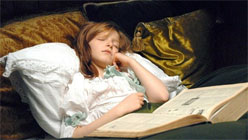In her filmic retelling of the Sleeping Beauty tale (her second take on a classic folktale, after 2009’s Bluebeard), French auteur Catherine Breillat not only updates the story, but offers viewers an unconventional focus. Instead of dwelling on a castle covered in thorny vines and the prince’s attempting to break in, The Sleeping Beauty (La belle endormie) addresses the inner life of the sleeping girl. A fantasy without being fantastical (no showy special effects or elaborate set-building here), the film moves steadily and surprisingly through uncharted terrain, the tale providing Breillat a framework in which to explore a headstrong young woman’s coming of age.
Cursed to die at the prick of a yew spindle by an evil witch, Breillat’s princess is rescued from that fate by three familiar good witches. They bestow upon her several loopholes in the curse: instead of death, a 100-year slumber; the ability to wander through her dream life; and, most curiously, though she will fall asleep at age 6, she will wake a 16-year-old. When questioned on this point, the witch responsible shrugs, “Childhood lasts too long.”
 A quick cut and six years later we find Anastasia, stubborn and tomboyish, obsessed with clocks and dictionaries. Falling asleep amongst ticking, she slowly reads the definition for “hermaphrodite,” early on establishing the film’s interest in having Anastasia explore her dream world without gendered expectations — a lone explorer in a strange land.
A quick cut and six years later we find Anastasia, stubborn and tomboyish, obsessed with clocks and dictionaries. Falling asleep amongst ticking, she slowly reads the definition for “hermaphrodite,” early on establishing the film’s interest in having Anastasia explore her dream world without gendered expectations — a lone explorer in a strange land.
The “real world” occupies only the first 10 and last 20 minutes of the film. The remaining portion follows Anastasia as she pluckily and successfully negotiates the dream-logic of Breillat’s quietly weird world. She’s walking alone in a tutu? A train awaits her. Coach ambushed by murderous robbers? A young gypsy queen spares her life. At first simply moving from place to place absentmindedly, Anastasia launches herself into a grand quest when her adopted older brother hits puberty, becomes sullen and cruel, and flees with the Snow Queen into adulthood. (Her initial attempt to cure him by reading the definition of “puberty” in the dictionary doesn’t achieve the desired result.)
 This section of the film moves slowly, dare I say dreamily, with sudden jumps between each challenge the princess faces. Carla Besnaïnou, playing the young Anastasia, carries the film. She is a thoroughly engrossing on-screen presence — curious, imperious, and charming all at once. The most magical sequence comes as Anastasia travels through the icy terrain of Lapland on the back of a doe, seeking the advice of a yurt-bound wise woman. “I can’t give you stronger powers than those you possess,” the old woman says. Breillat’s ill-concealed suggestion to all women, perchance? Anastasia’s solo journey cannot last forever, however, and so our heroine opens her eyes to a reality closely resembling the present day.
This section of the film moves slowly, dare I say dreamily, with sudden jumps between each challenge the princess faces. Carla Besnaïnou, playing the young Anastasia, carries the film. She is a thoroughly engrossing on-screen presence — curious, imperious, and charming all at once. The most magical sequence comes as Anastasia travels through the icy terrain of Lapland on the back of a doe, seeking the advice of a yurt-bound wise woman. “I can’t give you stronger powers than those you possess,” the old woman says. Breillat’s ill-concealed suggestion to all women, perchance? Anastasia’s solo journey cannot last forever, however, and so our heroine opens her eyes to a reality closely resembling the present day.

 While the film revels in Anastasia’s childhood, the narrative finally admits to the impossibility of avoiding the draw of companionship. Awakened by the modern version of a prince (a handsome piano-playing lothario), Anastasia must contend with her literal as well as sexual awakening. Losing their dream world rationale and strange nuance, the film’s symbols become a bit heavy-handed in modern times. The older Anastasia (Julia Artamonov resembling a Pre-Raphaelite painting) delivers her lines with rapid ferocity, skillfully playing a teenager not yet in touch with or in control of her emotions. Experiencing lust, jealousy, and heartache for the first time, Anastasia is suddenly thrust into an adult world and a different time, left to discover whether or not relying on her instincts will carry her through this new and more permanent journey.
While the film revels in Anastasia’s childhood, the narrative finally admits to the impossibility of avoiding the draw of companionship. Awakened by the modern version of a prince (a handsome piano-playing lothario), Anastasia must contend with her literal as well as sexual awakening. Losing their dream world rationale and strange nuance, the film’s symbols become a bit heavy-handed in modern times. The older Anastasia (Julia Artamonov resembling a Pre-Raphaelite painting) delivers her lines with rapid ferocity, skillfully playing a teenager not yet in touch with or in control of her emotions. Experiencing lust, jealousy, and heartache for the first time, Anastasia is suddenly thrust into an adult world and a different time, left to discover whether or not relying on her instincts will carry her through this new and more permanent journey.
